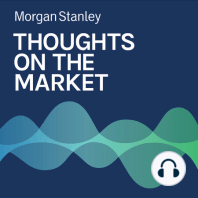4 min listen

Behind the Rapid Growth of the Private Credit Market
Behind the Rapid Growth of the Private Credit Market
ratings:
Length:
7 minutes
Released:
Feb 22, 2024
Format:
Podcast episode
Description
As traditional financial institutions tightened their lending standards last year, private credit stepped in to fill some of the gaps. But with rates now falling, public lenders are poised to compete again on the terrain that private credit has transformed.----- Transcript -----Vishy Tirupattur: Welcome to Thoughts on the Market. I am Vishy Tirupattur, Morgan Stanley’s Chief Fixed Income Strategist. Along with my colleagues bringing you a variety of perspectives, today we’ll have a conversation with Joyce Jiang, our US leveraged finance strategist, on the topic of private credit.It's Thursday, February 22nd at noon in New York.Joyce, thank you for joining. Private credit is all over the news. Let’s first understand – what is private credit. Can you define it for us?Joyce Jiang: There isn't a consensus on the definition of private credit. But broadly speaking, private credit is a form of lending extended by non-bank lenders. It's negotiated privately on a bilateral basis or with a small number of lenders, bypassing the syndication process which is standard with public credit.This is a rather broad definition and various types of debt can fall under this umbrella term; such as infrastructure, real estate, or asset-backed financing. But what's most relevant to leveraged finance – is direct lending loans to corporate borrowers.Private credit lenders typically hold deals until maturity, and these loans aren't traded in the secondary market. So, funding costs in private credit tend to be higher as investors need to be compensated for the illiquidity risk. For example, between 2017 and now, the average spread premium of direct lending loans is 250 basis points higher compared to single B public loans.Vishy Tirupattur: That’s very helpful Joyce. The size of the private credit market has indeed attracted significant attention due to its rapid growth. You often see estimates in the media of [the] size being around $1.5 to $1.7 trillion. Some market participants expect the market to reach $2.7 trillion by 2027. Joyce, is this how we should think about the market? Especially in the context of public corporate credit market?Joyce Jiang: I've seen these numbers as well. But to be clear, they reflect assets under management of global private debt funds. So not directly comparable to the market size of high yield bonds or broadly syndicated loans.In our estimate, the total outstanding amount of US direct lending loans is in the range of $630-710 billion. So, we see the direct lending space as roughly half the size of the high yield bonds or broadly syndicated loan markets in the US.Vishy Tirupattur: Understood. Can you provide some color on the nature of private credit borrowers and their credit quality in the private credit space?Joyce Jiang: Traditionally, private credit targets small and medium-sized companies that do not have access to the public credit market. Their EBITDA is typically one-tenth the size of the companies with broadly syndicated loans. However, this is not representative of every direct lending fund because some funds may focus on upper middle-market companies, while others target smaller entities.Based on the data that’s available to us, total leverage and EBITDA coverage in private credit are comparable to a single B to CCC profile in the public space. Additionally, factors such as smaller size, less diversified business profiles, and limited funding access may also weigh on credit quality.Given this lower quality skew and smaller size, there have been concerns around how these companies can navigate the 500 basis point of rate hikes. However, based on available data, two years into the hiking cycle, coverage has deteriorated – mainly due to the floating-rate heavy nature of these capital structures. But on the bright side, leverage generally remained stable. Similar to what we’ve seen in public credit.Now let me turn it around to you, Vishy. What about defaults in private credit and how do they compare to public credit
Released:
Feb 22, 2024
Format:
Podcast episode
Titles in the series (100)
Andrew Sheets: Fed to the Rescue? Maybe Not. by Thoughts on the Market